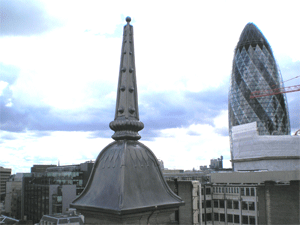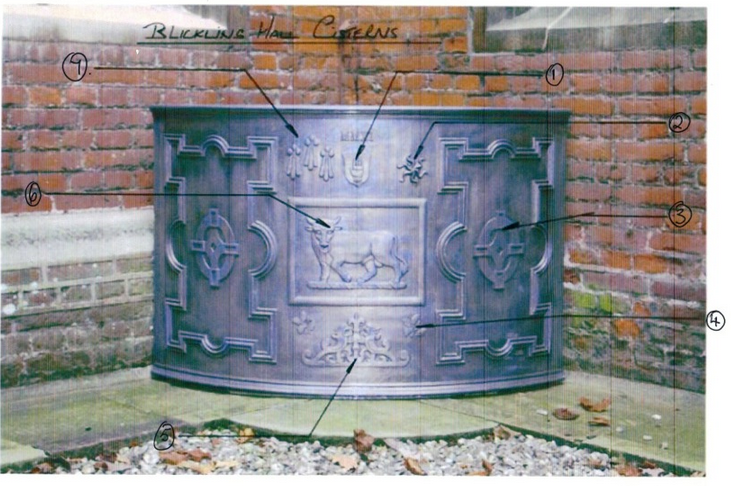Decorative Leadwork - Reflecting the skill of early craftsmen
 Beaten, twisted, cut or cast, ornate designs bear out the skill and artistry of early craftsmen. And surviving examples are under threat. Douglas Kent, SPAB Technical Secretary, elaborates and answers some FAQ's.
Beaten, twisted, cut or cast, ornate designs bear out the skill and artistry of early craftsmen. And surviving examples are under threat. Douglas Kent, SPAB Technical Secretary, elaborates and answers some FAQ's.
Q. Where is decorative leadwork used, and why save it?
A. The artistic skills of the leadworker have typically found expression on rainwater heads, downpipes, water cisterns and roof embellishments, as well as statuary. Employed on numerous ecclesiastical and important secular buildings, decorative leadwork reached its apogee from late medieval times up to the end of the 18th century. Despite the fine craftsmanship, much of Britain’s historic leadwork has been lost or is threatened. Not only is there a lack of appreciation of decorative leadwork and its conservation, even non-ornamental plumbing leadwork skills are now scarce.
Q. What are the techniques for decorating leadwork?
A. Decoration is formed either by working lead sheet with tools, or casting molten lead directly into moulds. Plumbing leadwork skills, such as joint solder wiping and pipe fabrication, are required as well as specialist decorative techniques. Decorative interest can be created by: dressing lead over moulds to form shapes such as faces (repoussé work); carving with gouges or forming pierced tracery with chisels, punches and knives; beating into ornate finials, crestings etc (wrought work); and casting into open sand, chill or other types of mould. Surface decoration is also possible.
Q. Was leadwork colourfully decorated in the past?
A. Frequently. We have become accustomed to the attractive silvery grey finish of architectural leadwork. Historically, whole roofs, girouttes, flèches, ogee domes, lanterns, pennons and spires offered dazzling displays of chequer-work and chevrons. Rainwater heads and cisterns, too, were treated colourfully. Surface decoration was achieved by gilding, tinning, painting and, sometimes, through artificial patination, mastic inlays or etching.
Q. In what ways can decorative leadwork deteriorate?
A. Though lead is highly durable, degradation can occur. Some problems are associated with lead in general, such as acid corrosion or, with roofs, thermal stress failure. Defects specific to decorative leadwork range from the deterioration of wrought iron armatures and cores in cast objects to damage by birds to delicate tracery. Weathering degrades gilding, tinning and paint.
Q. How is decorative leadwork repaired?
A. Lead is the perfect material to repair. It is possible to cut out a damaged section and insert a matching new piece (sand-cast or milled, as appropriate) to produce an invisible joint. Soldering and solder wiping are often used here and for making good small splits and pin-holes in decorative work. Where a rainwater head is in very poor condition, a new lead reservoir can be made and placed inside, with suitable reinforcement. Occasionally, a case exists for re-shaping distorted leadwork, such as when a piece no longer functions as intended (obstructing water flow etc). Work may also entail casting new parts or replacement of corroded wrought iron armatures with stainless steel.
Q. Why might leadburning be inappropriate with decorative leadwork?
A. It is important to copy the original method of jointing lead, in most cases to avoid changing the fundamental nature of a historic piece. There are many examples where unskilled individuals have tried to replace soldered joints by leadburning (welding) inside restricted rainwater head reservoirs, leaving globules of molten lead that cause debris to collect. Smooth wiped soldered joints would have been easier to perform to the benefit of water flow. Regardless of the method, remember fire safety with all hot work.
Q. Is it appropriate to apply colourful surface decoration on old leadwork?
A. Gilding, painting and other forms of surface decoration might be considered where it is known to have existed originally and would be to the benefit of the architectural whole. Lead-based paints were used historically, but legislation now restricts the sale of these for use to grade I and II* buildings, scheduled ancient monuments, and also works of art, which some decorative architectural leadwork objects might be classed as. Listed building or scheduled ancient monument consent may be required before reinstating decoration.
 So what is SPAB?
So what is SPAB?
The Society for the Protection of Ancient Buildings was founded by William Morris in 1877 to counteract the highly destructive 'restoration' of medieval buildings being practised by many Victorian architects. Today it is the largest, oldest and most technically expert national pressure group fighting to save old buildings from decay, demolition and damage.
We advise. We educate. We campaign. We offer help when it's wanted and informed resistance when we are alarmed. We encourage excellence in new design to enrich and complement the historic environment.
We represent the practical and positive side of conservation. We have a firm set of principles about how old buildings should be repaired and the practical knowledge to show how these can be put into effect.
 We are training the next generation to do the job with discernment and care and we are helping many others, who own or live in old buildings, to understand them better.
We are training the next generation to do the job with discernment and care and we are helping many others, who own or live in old buildings, to understand them better.
Our membership includes many of the leading conservation practitioners as well as home owners, living in houses spanning all historical periods, and those who simply care about old buildings.
Our successes are visible across the country. Thousands of historic buildings survive which would have been lost, mutilated or badly repaired without our intervention.
Today, the Society has a statutory role as adviser to local planning authorities. We must be notified of listed building applications that involve total or partial demolition. We are also informed by those religious bodies, that have an exemption from the secular system, of certain types of proposal for listed places of worship. In addition, our Casework includes campaigning to protect historic buildings at risk.
You can support SPAB through donations, legacies and sponsorship.
For further information visit www.spab.org.uk













